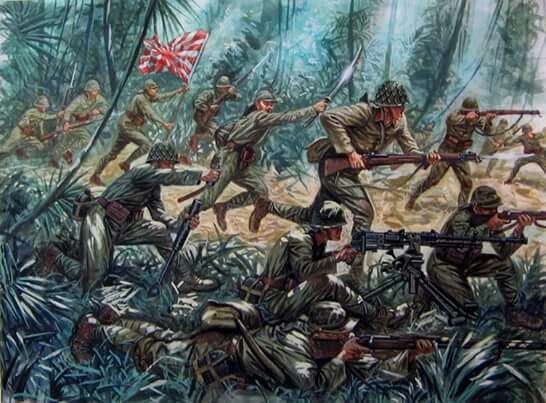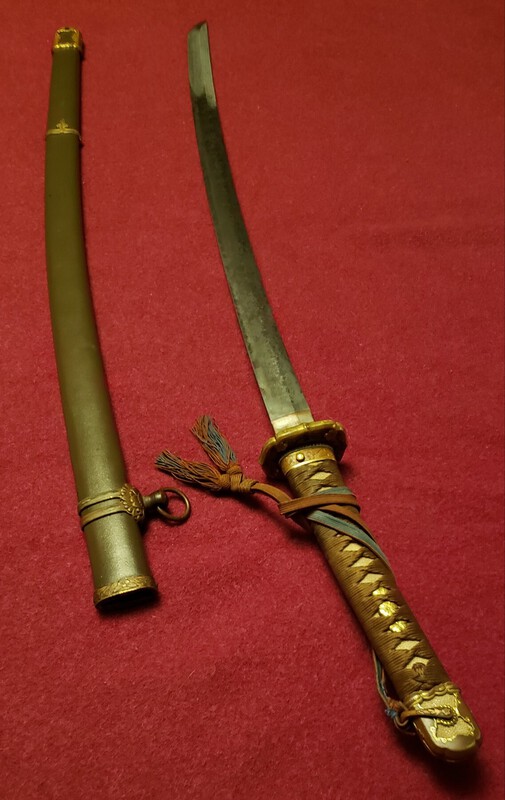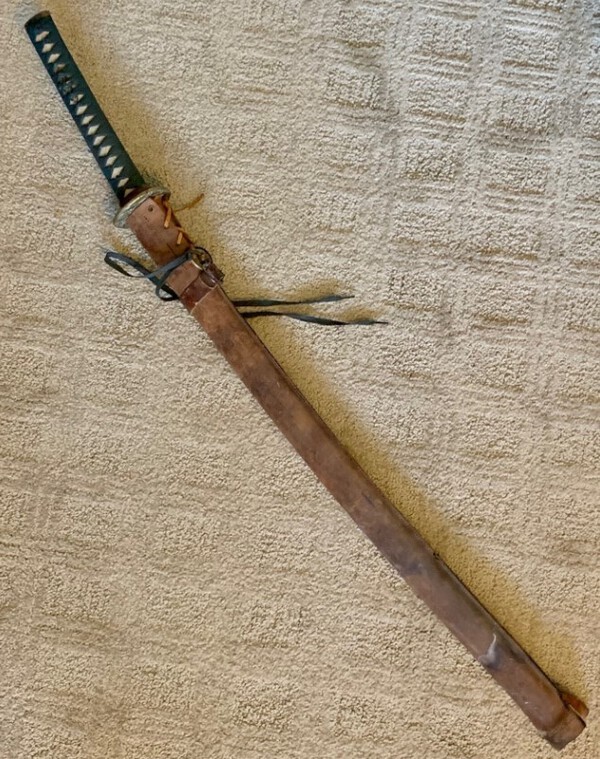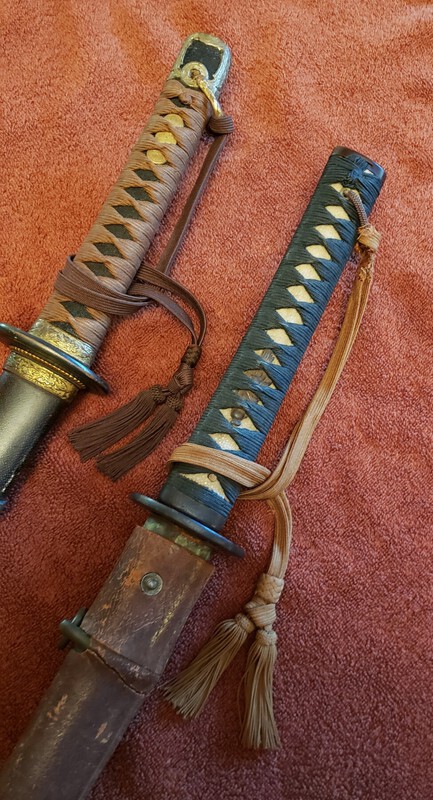-
Posts
341 -
Joined
-
Last visited
-
Days Won
1
Content Type
Profiles
Forums
Events
Store
Downloads
Gallery
Everything posted by Kolekt-To
-
Were darkened fittings more of a late-war phenomenon?
-
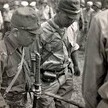
How common were Type 98 mounts on Wakizashi blades?
Kolekt-To replied to Kolekt-To's topic in Military Swords of Japan
Thanks for the info guys! And a very nice example Matthew. -
There is a Wakizashi in Type 98 mounts for sale on eBay currently ($5K USD, papered) and it got me thinking about how common this may have been during the war. I've seen plenty of Wakizashi in Type 97 (Kai Gunto) mounts, in fact I have one in my collection. Also, how common would it be for an officer to carry a Wakizashi in regulation military mounts vs a Wak in non-military mounts (from my understanding, Wakizashi in non-military mounts were allowed to be carried - these swords were not required to be in regulation mounts)?
-
Was it likely re-painted gold post-war? If not, why would they chose the color gold for a re-paint (during the war, or post-war)? Would there have been a shortage of regulation standard paint? And why would there be a need for repainting? This topic raises many questions.
-
Just saw this listed on the Bay. Appears to be one of those Post-War souvenir swords that has been discussed here on the NMB. What do you guys think about this sword?
-
So, it seems this Type 98 is credited to Seki smith "Kunihiro" in 1943. And this would be considered Showato (non-traditional blade, oil-tempered) as is common with guntos, correct?
-
Interesting what we prioritize at any given time in this hobby. I've prioritized accessory parts and accoutrements over the past several months. I felt that I had acquired a sufficient number of guntos this past year (21 Gunto in my collection currently) since my introduction to the hobby and I wanted a pause to focus on any needed repairs and parts/accessories acquisitions. So, I've spent some funds having some tsukas re-wrapped and some sayas restored or touched up (work performed by David McDonald or Randy Black), and I've purchased a number of original parts and accessories (including sarutes, sarute barrels, and tassels). I've made good progress. I still have a Type 98 that needs a tsuka re-wrap, and I may acquire one or two more tassels in the months ahead.
-

Shin-Gunto with BRASS mekugi? How to remove.
Kolekt-To replied to tbonesullivan's topic in Military Swords of Japan
Looks like that metal "mekugi" is permanently stuck and, alas, we may never see that nakago. Is there still hope? -

Gunto in Call Of Duty :Vanguard
Kolekt-To replied to BANGBANGSAN's topic in Military Swords of Japan
-
Not sure about the Jinsen Arsenal swords, but swords of this type in decent condition can go for $1200.00+ USD.
-
But is that saya genuine? It's a beautiful leather-covered saya - that leather looks great! That saya may be worth more than the sword.
-
Thanks Tony! I checked out his site - some good stuff at reasonable prices. I've done pretty well on needed parts and accessories at this point, and I now have a bit of a spare parts inventory. I'm always on the hunt for an extra Navy tassel - would like another one for one of my Kai Guntos. I recently purchased a Colonel's tassel to add to one of the favorites in my collection - a Type 98 with blade made by Masatsuna (circa 1690's).
-
From being in this hobby less than a year, and having collected more than 20 Gunto, thus far, I've noticed that many of the swords I've purchased have lacked sarutes, sarute barrels, and saya fittings such as the Ishizuke and Kuchigane (specifically Navy sayas). Also, most swords I've purchased, and see being sold, do not include tassels. Along with new swords to consider acquiring, I've found myself on the hunt for parts and accessories in recent months - made good progress and have improved the look of my swords that needed the goods. What have your experiences been with missing parts and accessories, and in acquiring these?
-
Just saw this photo included with a Gunto sale listing on eBay. I guess the seller is trying to emphasize the dull blade on his Type 98. But what really scares me is the broken tip - broken tips can be a pain to have re-shaped. You need to find someone who has been trained to do the work properly, there is wait time involved, and then there's the cost of the work.
-

My Pitted 98... and why it will remain "as is"
Kolekt-To replied to Kolekt-To's topic in Military Swords of Japan
The blade was cleaned. I think it's probably the lighting in the photo that made it look like a possible cosmoline stain on the blade. I'm going to take it out again in the days ahead and re-examine it. I'll clean and oil the blade again at that time. -
I watched a YouTube video demonstration to learn how to properly remove the tsuka and expose the nakago/tang. Although I had read about it, watching the video gave me confidence. I had been intimidated by the prospect of removing the tsuka, but shortly after I began collecting, and having acquired a few swords, I knew that the time had come to start examining nakagos. Gunto nerds need this basic skill. Lol
-
He probably never imagined that his surrendered Gunto would one day end up in Volker's sword collection in Germany. Lol Great story!
-

My Pitted 98... and why it will remain "as is"
Kolekt-To replied to Kolekt-To's topic in Military Swords of Japan
No nakago photos, currently. I've had it apart in recent months and had it examined by my mentor. He's of the opinion that it's probably a traditionally made blade. I'm not really concerned about it being Gendaito or Showato - I'm more focused on the blade's pitting and what, if anything, could be done about that. It's a sword that I debated whether or not to rid myself of, however, as explained, it's grown on me and I'll keep this Type 98 from Kuniyoshi in my collection. And, I won't be messing with the blade! Lol -

My Pitted 98... and why it will remain "as is"
Kolekt-To replied to Kolekt-To's topic in Military Swords of Japan
Bruno, it could very well be Gendaito. Seems that it might be a traditionally made blade. There are no seki or showa stamps on the tang, just smith name and date. The blade is heavy and appears well-made. If the blade wasn't so pitted, perhaps we would know for sure. I'm leaning toward Gendaito. -

My Pitted 98... and why it will remain "as is"
Kolekt-To replied to Kolekt-To's topic in Military Swords of Japan
-
Here's photos of one of the Type 98's in my collection (Kuniyoshi, 1945). This was one of the first swords I acquired when I began Gunto collecting earlier this year. I didn't know much then, and I probably would not have made the purchase today - who wants a sword with a pitted blade in their collection when you can find plenty with blades in much better shape? I paid less than $1000.00 for it, so I don't feel that bad about the buy (a beginner's mistake?), and the sword has grown on me over the months. And, I think the koshirae is really nice, as well. As we can see, the blade is extensively pitted. It's a shame that this sword was neglected over the years with the blade allowed to degrade. I've had it assessed and the pitting is so extensive that I've been told that it would take belt sanding to remove the pitting, and that's something I won't do. Sanding the blade to that extent would simply ruin it. It has historical value and, as mentioned, the koshirae is nice and in good condition - it displays well when the blade remains in the saya. Lol So, this one stays as is. Have any of you kept a less-than-desirable sword and/or chose not to mess with a messed-up blade?
-
Perhaps others can comment on this, but seems this color of Ito is quite common on the Gunzuko (Civilian) swords. As you can see from the photo I posted, the Ito on my example appears to the be the same color as yours, Was this color of Ito standard/regulation for Gunzuko swords?
-
Is that a remnant of a tassel attached to the saya? I attached one of Tim's photos for reference and one of mine featuring Navy and Civilian (Gunzuko) sword examples (focus on the tsukas) with their respective tassels attached for comparison.
-

Need recommendations for Tsuka repair and wraps
Kolekt-To replied to Kolekt-To's topic in Military Swords of Japan
Good luck Todd! It can be a challenge to find someone who does quality work and have it completed within our time frames. I've learned to be patient when it comes to this hobby. -

Need recommendations for Tsuka repair and wraps
Kolekt-To replied to Kolekt-To's topic in Military Swords of Japan
For the record, as I mentioned, Randy Black in Phoenix, AZ. is backlogged at least 3 months, as well. These Koshirae repair guys are not hurting for work. They provide a great service and have no shortage of customers.

